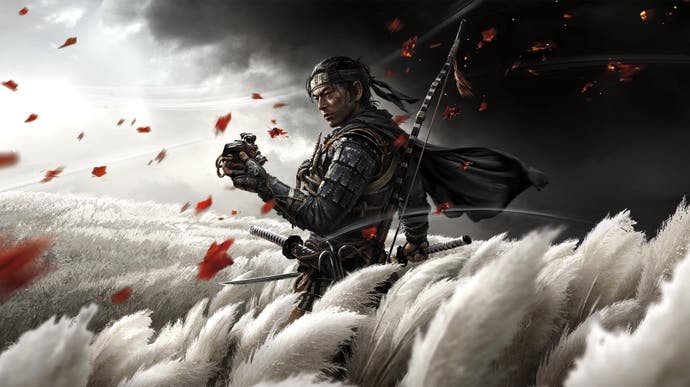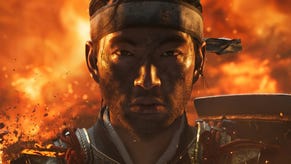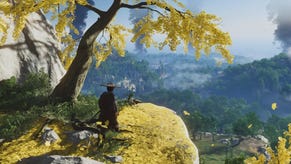Ghost of Tsushima review - a likeable, if clunky Hollywood blockbuster
The horse you ronin on.
Quite early on in Ghost of Tsushima, you'll be introduced to its dramatic, one-on-one duels. Two warriors, a dozen yards apart, face each other down across the divide. Up close: narrowing eyes and crumpled brows. Hands hover at hips, knees bend, feet press down into the earth, muscle, sinew and fingers tighten. Then - bang! - combat. It's a cracking moment, especially the first time you give one a try, and it's also a cracking example of what Ghost of Tsushima's all about. These heightened standoffs begin with shot-for-shot facsimiles of that famous scene from Yojimbo, an Akira Kurosawa classic that's both a mirror of older westerns and an inspiration for the '60s greats.
They're also, once you've done a few of them, slightly flat, the enemies you battle mostly re-using the same attacks and movements of ones you've faced before, and the concept quickly becomes a little overused, predictably occurring at the end of certain quests, and generally lacking the complexity to require more than a few tries each time. Like the game itself, they go for authenticity through facsimile - recreating moments without the requisite weight and context. And, like the game itself, they're lacking a little depth. Despite the immediate and undeniable thrill, the gloss can be just a little too quick to wear off.
Still, much of Ghost of Tsushima is enjoyable enough. Developer Sucker Punch has definitely aimed high with its first full-length effort since InFamous Second Son, way back at the start of the generation in 2014. The much-trumpeted inspirations here are the stirring epics of samurai cinema. It's a tough genre to crack, nevermind the potential for awkwardness in an American realisation of feudal Japan. Namechecked directors like Akira Kurosawa, who gets his own grainy, black-and-white mode in Ghost of Tsushima, are known for their lengthy epics of extraordinary nuance, adapting - and arguably mastering - the works of Shakespeare, or chipping away at the great problem of the human condition. Next to inspirations like that, Ghost of Tsushima is never really going to compare. It lacks the nuance and the depth, or the dedication, even, to telling a good story itself - as opposed to telling a story that simply keeps out of the way of the mechanics - and the slack left by its story isn't picked up in those mechanics, either. But it has a kind of Hollywood, popcorn charm, which shouldn't count for nothing.
In Ghost of Tsushima you are Jin Sakai, a samurai of noble birth, tasked with almost single-handedly fending off a Mongol invasion of the feudal Japanese island he calls home. In doing so you're forced to evolve, from staid and honourable samurai to the Ghost, master of underhand tactics. And therein lies your central conflict, as the screenwriting gurus would put it: Jin has to defend the people of the island, but he does so at great cost, abandoning tradition, honour, and everything that comes with it. It's a bit of a cliché - and one that happily departs from Sucker Punch's stated aim for authenticity, when you read historians' arguments that for most samurai in feudal Japan, there was no such code of honour at all - but Ghost of Tsushima is good at carrying you along with the drama.
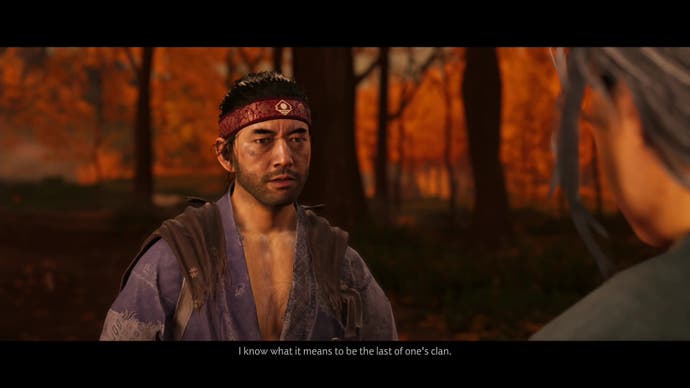
It's helped by some stellar voice work from a cracking cast, including a turn from the magnetic François Chau, of Lost fame, as a curmudgeonly master archer Sensei Ishikawa, and an imperious Patrick Gallagher as the big bad Khotun Khan, a fictional descendant of that famous one Ghengis. There are some stirring sequences, too, especially when Sucker Punch digs a little deeper into its characters to mine their pockets of rage, or just finds an excuse for another heroic charge, while the family-political intrigue is at least more accurate to the period than the lengthy monologuing on honour and tradition. And there's a stunning, sweeping score to accompany it all, capable of dragging you up from even the deepest mid-game cutscene malaise, carrying you across rolling landscapes and striking wonderfully at the story's noticeable highs.
What it lacks is the grit to go with the melodrama. Samurai tales are, famously, much the same as what we'd more quickly recognise as westerns, and as such they're reliant on certain things to really work. One of them is that grit, or rather a sort of tangible earthiness, that comes from a particular grounding in the world. There have been obvious examples of earthy cowboy games recently but the best illustration in this case remains The Witcher 3, which told a similar story of a stoic, semi-outlawed warrior riding into villages and solving problems with his sword, but did so through the immense weight of its world, through the detail and humanity of its side stories and the intimacy of its smaller, quieter moments. There are countless others - Assassin's Creed's now known for its side stories that bring levity, heart and mystery, and the first Red Dead Redemption has even been cited by Sucker Punch as inspiration.
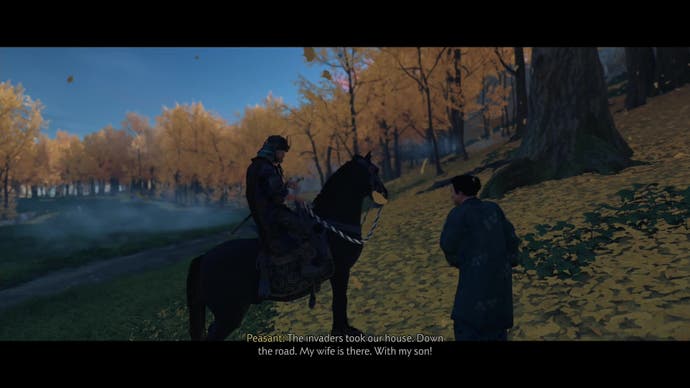
This is why Ghost of Tsushima feels so frustrating. Side quests are the beating heart of a good outlaw story, the secret to a great samurai game that so many others not set in feudal Japan have managed to master. For Sucker Punch they seem to have been almost an afterthought. There are effectively four kinds of quest in the game: the main story, one-off side quests, mythic quests, and "tales" - multi-step quests - that are tied to a specific named character. The character tales are far and away the highlight - Lady Masako and Ishikawa's standing out among them, thanks to the strength of the performances and melodrama of the stories - but they're sadly over before they really begin, and the actual activities involved are still far too limited. Follow a character, track some footsteps, fight some enemies and maybe grind out some instant-fail stealth sections, onto the next. There's some minor variation on this for the mythic ones but not much - not enough - and the standalone ones are worse, often feeling like a procedural patching together of pre-set objectives and activities, wrapped in the loose-fitting context of another unnamed peasant crying for help from the Mongols. The only reward for your time with them is a nudge of XP or some upgrade materials, as opposed to a chance to really bed yourself into the character or the world itself. They're a huge disappointment.
In fact, if you pick at the surface of Ghost of Tsushima it all starts to quite worryingly unravel. The world as a whole is beautiful - utterly, undeniably, oppressively beautiful. Such colour! Everywhere you look, it's crimson, windswept fields and forests of golden yolk. Sunsets and oceans, beaches and snowy mountain peaks - environments of improbable range for a temperate island of Tsushima's kind, set to broad, enrapturing splashes of orange and teal. The vivid green bamboo jungles, the ephemeral fireflies, the swirling, milky petals that rise and fall with the wind - a wind that could be a game of its own, a magic thing bending everything around you. It's a sign of a studio that's mastered the tech, with a console generation's worth of experience behind it, but what it's missing is the maturity or restraint to put it to use. Ghost of Tsushima's bursting with undeniable beauty, yes, but beauty of the obvious, in-your-face kind, the kind that doesn't offer much thematic or tonal subtlety but makes a great ad for HDR OLED televisions. It's an odd thing to find a problem with - an excess of sumptuousness - but Sucker Punch is best imagined here less as master painter than overexcited barkeeper, serving up shot after shot of wincingly concentrated emotion, slamming the table and pouring out another - bigger moon! more falling leaves! make it a double! - before you've gulped the last one down. It's a bit much.
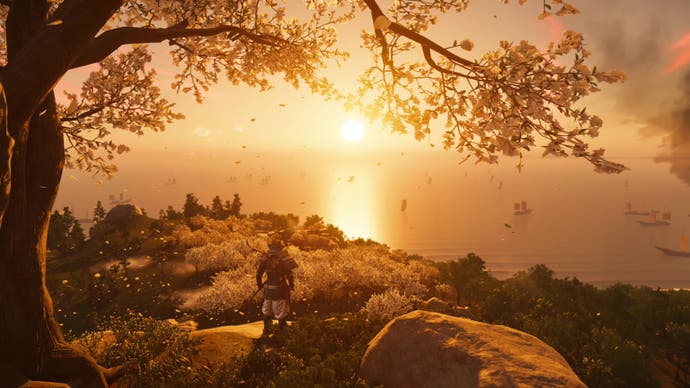
More troublesome is the construction of Tsushima's open world, which is technically open but best described as closed. It's a big area - there are three parts to the island, the second and third opening up after you reach the end of the first act plenty of hours in, and they contain all the breadth of those wildly varied biomes outlined above - but the sense of closedness comes from how little mystery there is to it. In fact, there's really no mystery at all, once you get to know the way the game works.
Spanning the island are a litany of fixed, more or less identical locations-of-interest, which all involve a set interaction and a set reward (and all of which you'll be led to by the game's clunky, if admirable attempt at using nature for navigation - gallop past a nearby point of interest and a golden bird will appear, piping up incessantly in invitation to follow it to whatever that undiscovered spot may be). Those points of interest never change, though - they never deviate from the set list of things to do that you can check off from lists in the menus. So there are hot springs which you press R2 at to bathe in and increase your max health; fox dens, where you follow a mewling, over-adorable fox to a shrine, which you press R2 at to increase your max charm slots; bamboo strikes, which do at least give you a very brief, quick-reaction button-pressing minigame to beat before their designated reward (there's an accessibility option for turning off the time-sensitive element, if that sounded worrying to you).
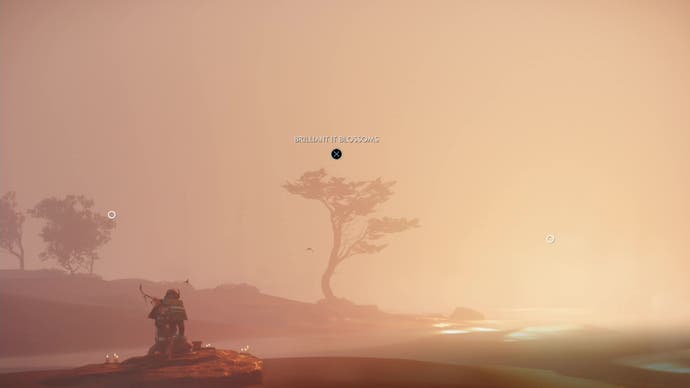
I could go on, but the point is sooner or later you'll realise this is it. A bird will chirp and, after slavishly following them until now, you'll decide the bird can do one, actually, because it's just going to take you off your path to something you've already seen and done a dozen times before. Even the rarer, more elaborate activities like Shinto Shrines - locations that sit atop mountains and cliffs, requiring a spot of ultra-light, golden ledge guided platforming to reach - start to wear thin after a couple climbs. The result of it all is a busy world, full of activities, but one that soon feels paradoxically empty of things to do.
A brighter, if still imperfect part of Ghost of Tsushima is its combat. In melee, Sucker Punch has created a kind of Arkham-Sekiro hybrid, which works relatively well. Enemies all have a guard meter as well as a health meter, which will need to be broken for you to really get in there with the pointy end of your katana and do some damage. Much of your success will come from successfully countering, as is the Arkham style: you can dodge and perfect dodge, dodge-roll, parry, and perfect parry, all of which feel snappy enough - although I'd like some attack-cancelling to feel a tad sharper. And while there are unblockable enemy moves, marked with a red symbol - hello Sekiro - most of these can be turned into parryable ones with an early upgrade in the skill tree (Ghost of Tsushima has something between seven and ten skill trees, depending on how you look at it - don't ask), which unfortunately takes away much of the tension and skill.
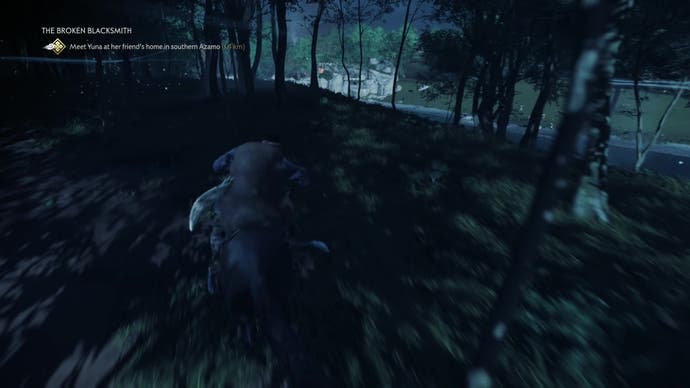
Where it gets interesting is stances: there are four stances in the game, each granting new heavy attacks effective at breaking the guards of a certain type of enemy. You unlock them and their respective skill trees one at a time - with another slightly repetitive open world task of killing certain numbers of Mongol leaders - but once you do the combat gets noticeably more interesting, becoming a much more conscious exercise. At its most satisfying, you'll be facing swollen numbers of varied enemies, requiring you to rapidly switch between stances as frequently as every enemy attack, so as to clash swords, break shields, charge archers, parry spears and slash brutes as effectively as possible. In these moments of intimate violence, the music soaring, enemies cowering and crumpled, Jin clad in some imperious armour lashed with rain and soaked in mud, Ghost of Tsushima feels glorious, and also truest to its soily roots.
The problem is they come too rarely - there are a smattering of climactic battles in the story that open with a bang, before swiftly fizzling out - and too late, with the enemies only getting really varied and dense towards the end and the game falling into the usual RPG-lite trap of dishing out its most enjoyable gimmicks after a load of time without (or hiding them behind mythic quests, some of which are only accessible after certain points of the story). It struggles with the camera, which sits too low and close over the shoulder, and doesn't come with an option to lock onto an enemy. It sounds minor, but can result in annoying hits from enemies out of shot, an awkward inability to act and look around at once, or worse still a totally obscured camera altogether, if you get too close to an object or wall.
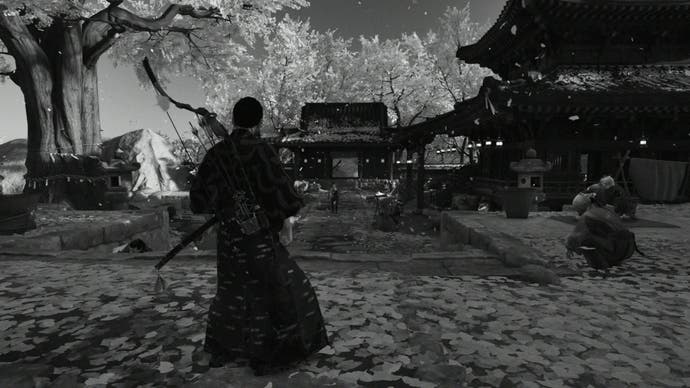
Ghost of Tsushima's stealth, meanwhile - which is prominent enough to be the driving force of its story, and technically half of your own arsenal - is frustratingly unsystemic and largely underbaked. It's very much stealth-lite, closest to modern era Assassin's Creed with even fewer toys, and so you'll be frequently defaulting to the usual suspects: X-ray vision, throw a jingly distraction bell, pop a smoke bomb if you get in trouble and try again. All of that couples meekly with a range of insta-fail stealth missions and yet another selection of excessively crunching, crackling and squelching neck stabs.
It's desperately frustrating, because I maintain that Ghost of Tsushima is still, largely, quite fun. The problem is it's an easy, breezy, lite beer kind of fun - the kind that Sucker Punch is known for, after all - and the blanket genericism of it just doesn't sit well against such a po-faced tone. It's another game fallen victim to the palatability blender, coming out the other side as a slightly formless smudge of every genre, without a mastery of any. Going back to Ghost of Tsushima's roots, as an American game inspired by the comics and the movies of Japan, in a way it's quite apt. It's what happens when you want to pay homage, but don't want to add anything new of your own. It's Hollywood.
